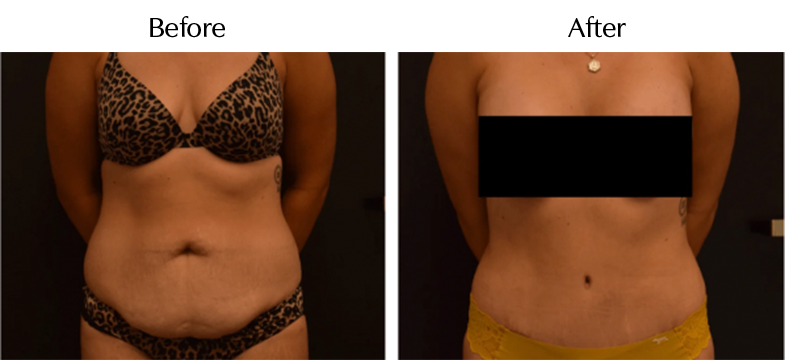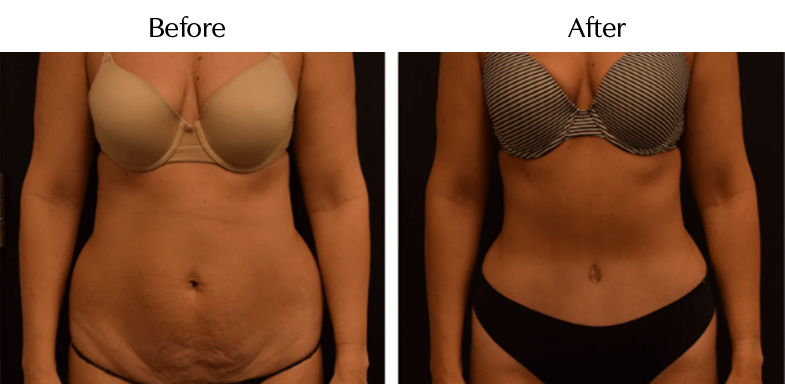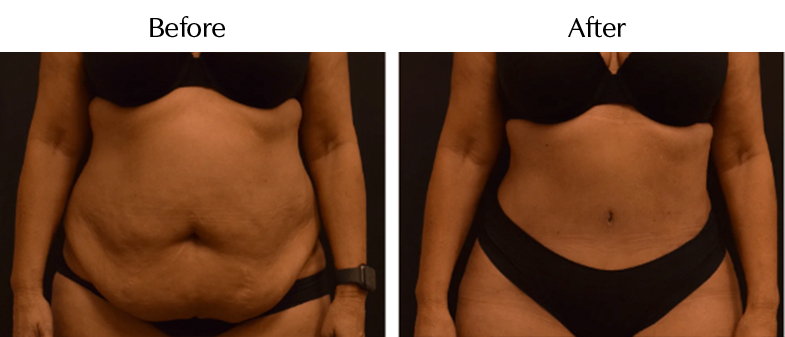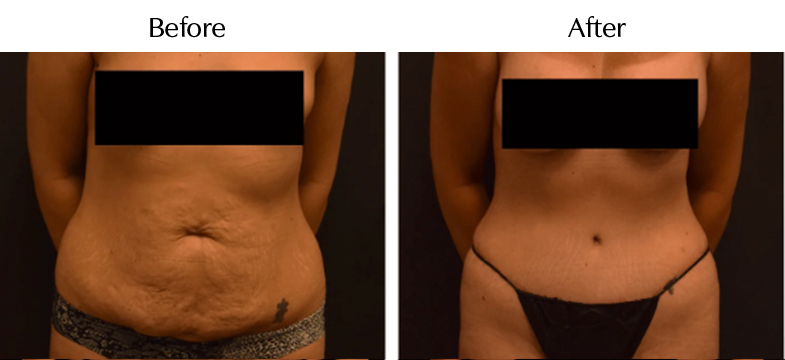About Tummy Tuck Surgery
Also known as abdominoplasty, a tummy tuck removes excess fat and skin and, in most cases, restores weakened or separated muscles, creating an abdominal profile that is smoother and firmer. A flat and well-toned abdomen is something many of us strive for through exercise and weight control. Sometimes these methods cannot achieve our goals.
Board-certified plastic surgeon Dr. Kiran Polavarapu will expertly perform your abdominoplasty in Fort Worth. This procedure tightens and restores your muscles to contour your shape. It can also partially or wholly address loose skin and stretch marks.
The reality is that even individuals of otherwise normal body weight and proportion can develop an abdomen that protrudes or is loose and sagging. The most common causes of this include:
- Pregnancy
- Aging
- Significant fluctuations in weight
- Heredity
- Prior surgery
Tummy tuck surgery is a highly individualized procedure and you should do it for yourself, not to fulfill someone else’s desires or to try to fit any sort of ideal image, even when performed by a tummy tuck specialist such as Dr. Polavarapu.

Benefits of Tummy Tuck Procedure
A tummy tuck, or abdominoplasty, offers several benefits, including the following:
- Flatter and Firmer Abdomen: Removing excess fat and skin tightens the abdominal muscles for a smoother, more toned appearance.
- Muscle Repair: It can repair weakened or separated abdominal muscles, commonly occurring after pregnancy or significant weight loss.
- Improved Posture: Strengthening the abdominal muscles can relieve back pain and improve posture.
- Enhanced Body Proportions: It can improve body proportions by creating a smoother and firmer abdominal profile.
- Boost in Self-Confidence: A flatter, more contoured abdomen often boosts self-esteem and confidence.
- Potential Health Benefits: It may alleviate back pain and urinary incontinence issues associated with weakened abdominal muscles.
- Clothing Fit: Clothes may fit better and feel more comfortable after removing excess skin and fat.
- Easier weight maintenance: After a tummy tuck, maintaining a healthy weight and active lifestyle can become easier due to improved muscle tone and reduced excess skin.
Abdominoplasty Candidates
Abdominoplasty may be right for you if:
- You are physically healthy and at a stable weight
- You have realistic expectations
- You do not smoke
Excess Abdominal Skin: Individuals with loose, sagging skin in the abdominal area, often due to significant weight loss or pregnancy, are prime candidates.
Weakened Abdominal Muscles: Those with weakened or separated abdominal muscles (diastasis recti) that have not responded to exercise can benefit greatly. A tummy tuck can tighten these muscles to restore core strength and stability.
Stable Weight: Candidates should be at a stable weight close to their ideal body weight. Significant fluctuations in weight after surgery can affect results.
Generally Healthy: Good overall health is essential for surgery. This includes being free from chronic medical conditions that could pose risks during or after the procedure.
Realistic Expectations: Understanding what a tummy tuck can and cannot achieve is crucial. Candidates should have realistic expectations about the outcomes of the surgery.
Commitment to Recovery: The recovery process requires commitment to follow post-operative instructions, including rest, activity restrictions, and proper incision wound care.
Although the results of an abdominoplasty performed in Fort Worth are technically permanent, the positive outcome can be greatly diminished by significant fluctuations in your weight. For this reason, individuals who are planning substantial weight loss or women who may be considering future pregnancies may be advised to postpone abdominoplasty surgery.
What a tummy tuck won’t do: Tummy tucks are not a substitute for weight loss or an appropriate exercise program. Also, tummy tuck operations cannot correct stretch marks, although these may be removed or somewhat improved if they are located on the areas of excess skin that will be excised, generally the treated areas below the belly button.
Choosing between a tummy tuck and liposuction depends on your goals. A tummy tuck removes excess skin and tightens muscles, ideal for those with loose skin after weight loss or pregnancy. Liposuction targets fat removal without addressing skin laxity. It's best if you have good skin elasticity and muscle tone but want to target specific areas of fat. However, consult with an abdominoplasty plastic surgeon such as Dr. Kiran Polavarapu in Fort Worth to determine the best option for you. She can assess your situation and recommend the most suitable procedure.
Types of Tummy Tucks
Full Tummy Tuck Versus Mini Tummy Tuck
A full tummy tuck and a mini tummy tuck are both cosmetic surgeries designed to enhance the appearance of the abdomen. Yet, they differ significantly in scope and results.
A full tummy tuck, or abdominoplasty, addresses the entire abdominal area. During this procedure, Dr. Polavarapu removes excess skin and fat from above and below the belly button and tightens the abdominal muscles.
A full tummy tuck typically involves a horizontal incision between the hip bones, just above the pubic area, and sometimes an additional incision around the belly button. This surgery is ideal for individuals with significant excess skin, fat, and muscle laxity, often due to substantial weight loss or multiple pregnancies.
In contrast, a mini tummy tuck focuses only on the lower abdomen, below the belly button. It involves removing less skin and fat and may include minor muscle tightening. The incision is usually shorter and located just above the pubic area. This procedure is best for those with minimal excess skin and fat below the belly button and generally good muscle tone.
When choosing between the two, consider the extent of loose skin and muscle separation. A full tummy tuck addresses extensive skin laxity and muscle issues more effectively. On the other hand, a mini tummy tuck provides less dramatic results. During your consultation, Dr Polavarapu, an abdominoplasty plastic surgeon, will help you determine the most appropriate procedure for individual health, body condition, and aesthetic goals.
Dr. Polavarapu is a talented and amazing surgeon. She is kind and caring in her treatment with excellent help. I love my results from breast reconstruction and tummy tuck.
 Sharon H. - Tummy Tuck Patient
Sharon H. - Tummy Tuck Patient
7 months ago
Why Choose Dr. Polavarapu for a Tummy Tuck?
Come in today and meet one on one with Fort Worth tummy tuck specialist Dr. Kiran Polavarapu, and you’ll quickly feel at ease with her friendly demeanor. She is a board-certified plastic surgeon who specializes in aesthetic and reconstructive plastic surgery, including as an abdominoplasty plastic surgeon. She attended the University of Missouri–Kansas City for medical school, earning a combined B.A.-M.A. She then completed her residency in general surgery at Beth Israel Deaconess in Boston, a Harvard University training program. She received her fellowship training in cosmetic/aesthetic surgery under the auspices of the renowned plastic surgeon Dr. Donald Wood-Smith at the New York Eye and Ear Infirmary. There, she further enhanced her expertise and finesse for her patients’ benefit. Dr. Polavarapu is certified by the American Board of Plastic Surgery and is a member of the American Society of Plastic Surgeons.
You can feel confident with this tummy tuck specialist handling your procedure. Dr. Polavarapu is a three-time winner of Fort Worth Magazine’s designation of Top Doctor, and was recognized as a Texas Monthly Magazine 2024 Super Doctor, becoming well-known as a top choice for abdominoplasty surgery. Known for her approachable Southern charm, she combines her Harvard training and education with her artistic ability to provide compassionate, friendly care that fulfills the needs of each individual patient.

Highlights
Before and After Photos




THE PROCESS
What to expect with a tummy tuck
In your initial consultation, your abdominoplasty plastic surgeon will evaluate your health, determine the extent of fat deposits in your abdominal region, and carefully assess your skin tone. Be sure to tell your surgeon if you smoke, and if you’re taking any medications, vitamins, or other drugs.
Be frank in discussing your expectations with your surgeon. He or she should be equally frank with you, describing your alternatives for a tummy tuck in Fort Worth and the risks and limitations of each.
If, for example, your fat deposits are limited to the area below the navel, you may require a less complex procedure called a partial abdominoplasty, also known as a mini-tummy tuck, which can often be performed on an outpatient basis. You may, on the other hand, benefit more from partial or complete abdominoplasty done in conjunction with liposuction to remove fat deposits from the hips, for a better body contour. Or maybe liposuction alone would create the best result.
In any case, your surgeon should work with you to recommend the tummy tuck in Fort Worth that is right for you and will come closest to producing the desired body contour.
During the consultation, your abdominoplasty plastic surgeon should also explain the anesthesia he or she will use, the type of facility where the surgery will be performed, and the costs involved. In most cases, health insurance policies do not cover the cost of a tummy tuck, but you should check your policy to be sure.
Your surgeon will give you specific instructions on how to prepare for surgery, including guidelines on eating and drinking, smoking, and taking or avoiding certain vitamins, and medications.
If you smoke, plan to quit at least one to two weeks before your tummy tuck in Fort Worth, not resuming for at least two weeks after your surgery. Avoid overexposure to the sun before surgery, especially to your abdomen, and do not go on a stringent diet, as both can inhibit your ability to heal. If you develop a cold or infection of any kind, your surgery will probably be postponed.
Whether your surgery is done on an outpatient or inpatient basis, you should arrange for someone to drive you home after your surgery, and to help you out for a day or two after you leave the hospital, if needed.
Many surgeons perform both partial and complete abdominoplasties in an outpatient surgical center or an office-based facility. Others prefer the hospital, where their patients can stay for several days. Dr. Polavarapu performs hers at the Texas Health Cleburne Surgical Center. This top-quality medical facility shares her values and focuses on patient safety, comfort, convenience, communication, and optimal clinical care. Texas Health Cleburne Surgical Center is an ambulatory surgery center specifically designed for the needs and care of people undergoing outpatient surgical procedures.
Your doctor may select general anesthesia, so you’ll sleep through the operation.
Other surgeons use local anesthesia, combined with a sedative to make you drowsy. You’ll be awake but relaxed, and your abdominal region will be insensitive to pain. (However, you may feel some tugging or occasional discomfort.) Dr. Polavarapu will provide information about your specific abdominoplasty in Fort Worth, answer your questions, and address any concerns with care and compassion.
A complete tummy tuck usually takes two to five hours, depending on the extent of work required. Partial tummy tucks may take an hour or two.
Most commonly, the abdominoplasty plastic surgeon will make a long incision from hipbone to hipbone, just above the pubic area. A second incision is made to free the navel from surrounding tissue. With partial abdominoplasty, the incision is much shorter and the navel may not be moved, although it may be pulled into an unnatural shape as the skin is tightened and stitched.
Next, the surgeon separates the skin from the abdominal wall all the way up to your ribs and lifts a large skin flap to reveal the vertical muscles in your abdomen. These muscles are tightened by pulling them close together and stitching them into their new position. This provides a firmer abdominal wall and narrows the waistline.
The skin flap is then stretched down and the extra skin is removed. A new hole is cut for your navel, which is then stitched in place. Finally, the incisions will be stitched, dressings will be applied, and a temporary tube may be inserted to drain excess fluid from the surgical site.
In partial abdominoplasty, the skin is separated only between the incision line and the navel. This skin flap is stretched down, the excess is removed, and the flap is stitched back into place.
Dr. Polavarapu goes above and beyond to provide the best possible results for each patient who undergoes a tummy tuck in Fort Worth. This starts in the planning stages when she takes extra time to prepare for the surgery. This includes taking pictures of your abdomen to evaluate how to place the incision below your preferred panty line.
During the abdominoplasty in Fort Worth, she goes beyond standards, ensuring that the tummy itself looks good post-surgery and that the tummy area smoothly transitions into the rest of the body. This could include using liposuction for additional smoothing, something that other abdominoplasty plastic surgeons charge extra to perform. She also conducts a natural pinch test before you awake to ensure that the belly surface is even; if it doesn’t meet her standards, she uses a finer cannula for additional sculpting so there is no rippling effect.
Dr. Polavarapu pays special attention to the belly button to ensure a natural shape that hides the scar, one that curves in rather than looking flat and operated upon. This way, people won’t be able to tell you had a tummy tuck in Fort Worth.
After Your Surgery
Post-Surgical expectations
For the first few days after your tummy tuck in Fort Worth, your abdomen will probably be swollen and you’re likely to feel some pain and discomfort, which can be controlled by medication. Depending on the extent of the surgery, you may be released within a few hours or you may have to remain hospitalized for two to three days.
Your doctor will give you instructions for showering and changing your dressings. And though you may not be able to stand straight at first, you should start walking as soon as possible.
Surface stitches will be removed in five to seven days, and deeper sutures, with ends that protrude through the skin, will come out in two to three weeks. The dressing on your incision may be replaced by a support garment.
It may take you weeks or months to feel like your old self again. If you start out in top physical condition with strong abdominal muscles, recovery from a tummy tuck will be much faster. Some people return to work after two weeks, while others take three or four weeks to rest and recuperate.
Exercise will help you heal better. Even people who have never exercised before should begin an exercise program to reduce swelling, lower the chance of blood clots, and tone muscles. Vigorous exercise, however, should be avoided until you can do it comfortably.
Your scars may actually appear to worsen during the first three to six months as they heal, but this is normal. Expect it to take nine months to a year before your scars flatten out and lighten in color. While they’ll never disappear completely, abdominal scars will not show under most clothing, even under bathing suits.
A tummy tuck, whether partial or complete, produces excellent results for patients with weakened abdominal muscles or excess skin. And in most cases, the results are long lasting, if you follow a balanced diet and exercise regularly.
If you’re realistic in your expectations and prepared for the consequences of a permanent scar and a lengthy recovery period, a tummy tuck may be just the answer for you.


All Surgery Carries Some Uncertainty and Risk
Thousands of abdominoplasties are performed successfully each year. When done by a qualified female plastic surgeon who is trained in body contouring, the results are generally quite positive. Nevertheless, there are always risks associated with surgery and specific complications associated with this procedure.
Post-operative complications such as infection and blood clots are rare, but can occur. Infection can be treated with drainage and antibiotics, but will prolong your hospital stay. You can minimize the risk of blood clots by moving around as soon after the body contouring surgery as possible.
Poor healing, which results in conspicuous scars, may necessitate a second operation. Smokers should be advised to stop, as smoking may increase the risk of complications and delay healing.
You can reduce your risk of complications by closely following your abdominoplasty plastic surgeon’s instructions before and after the surgery, especially with regard to when and how you should resume physical activity.
How Long Do Results Last?
The results of abdominoplasty, or a tummy tuck in Fort Worth, performed by Dr. Polavarapu at the Texas Health Cleburne Surgical Center, can be long-lasting, but several factors influence them. Generally, the improvements in abdominal contour and muscle tightness can last for many years, especially if you maintain a stable weight and a healthy lifestyle. With proper care and a healthy lifestyle, many patients enjoy the benefits of their tummy tuck for a decade or more.
However, while a tummy tuck can address many issues, it cannot stop the natural aging process. Over time, some skin laxity might return, but it is generally much less than before the surgery. Future pregnancies can affect the results by stretching the skin and muscles again. It's usually recommended to wait until you are finished having children before undergoing a tummy tuck.
Can A Tummy Tuck Be Combined with Another Surgery?
A tummy tuck can be combined with other surgeries to tackle multiple concerns in one go. This comprehensive approach enhances results and means just one recovery period and a single set of surgical and anesthesia fees.
Many of our patients, especially after weight loss or pregnancy, see incredible benefits from combining a tummy tuck with liposuction or breast enhancement. This combination, often part of a mommy makeover, offers a transformative experience.
Before combining procedures, thoroughly discussing them with a board-certified plastic surgeon is crucial. They can guide you on safe and effective combinations based on your health and goals, ensuring optimal results.
How Much Does a Tummy Tuck Cost in Fort Worth?
A tummy tuck in Fort Worth starts at $13,000.
At Polavarapu Plastic Surgery, we're committed to transparency about the procedure's costs. Dr. Polavarapu performs liposuction of the abdomen and the flanks as part of this procedure. The price typically includes:
- The surgical facility fees
- Anesthesia costs
- Any necessary implants
- Post-surgery garments
- Follow-up appointments at two days, one week, two weeks, one month, three months, and annually as needed.
*Kindly note that facility and anesthesia fees are based on the duration of the procedure and are not charged by Dr. Polavarapu.
Since tummy tucks are considered cosmetic procedures, insurance does not cover them. For more information on payment options, please visit our financing options page.
Choosing a highly qualified, board-certified abdominoplasty plastic surgeon like Dr. Polavarapu means investing in expertise that reduces risks, ensures a smoother recovery, and provides natural-looking results. The cost of a tummy tuck in Fort Worth includes comprehensive care and personalized attention to get the best results for you.
Schedule Your Professional Consultation
If you’re interested in an abdominoplasty in Fort Worth, the first step is a professional consultation with Dr. Polavarapu. You’ll have the opportunity to share your concerns and goals with a true tummy tuck specialist, who will help you determine what procedure would be the most appropriate. Factors she considers include your general health, body condition, and aesthetic goals. Dr. Polavarapu and her entire team are known for being friendly and welcoming and for providing a comfortable experience from the consultation through the surgery and follow-up visits. For your consultation for a tummy tuck in Fort Worth, please connect with us online, stop by our office, or call 817-615-8576.
Polavarapu Plastic Surgery is conveniently located on Edwards Ranch Road near the Shops at Clearfork in Fort Worth. To schedule a tummy tuck consultation with Dr. Polavarapu, please get in touch with us online, call 817-615-8576 or stop by our office.
Hours of Operation:
Monday 8:30 AM–5 PM
Tuesday 8:30 AM–5 PM
Wednesday 8:30 AM–5 PM
Thursday 8:30 AM–5 PM
Friday 8:30 AM–12:30 PM
Saturday and Sunday Closed
We look forward to seeing you.
TUMMY TUCK FAQS
Have a specific question? Contact us!
A tummy tuck is a plastic surgery procedure medically called an abdominoplasty. The goal is to remove excess skin and fat in the belly area and tighten the muscles to improve its shape and appearance. Sometimes, weight control and exercise are insufficient to achieve the desired appearance. That’s because, even if you’re of normal weight, it’s possible to have an abdomen with loose, sagging skin and separated muscles. A tummy tuck can help firm up the skin and repair the musculature to create a slimmer, flatter-looking belly.
Because a tummy tuck, which is also called abdominoplasty, cannot help you lose considerable weight, most candidates for the surgery are already at a stable, healthy weight. So, a good candidate for a tummy tuck in Fort Worth includes people without major medical problems who are at a stable, healthy weight and who would like to have the extra fat and/or skin from the belly area removed and the muscles tightened for a smooth, attractive appearance.
A tummy tuck cannot remove stretch marks, but it can correct issues with your abdomen related to:
- Aging
- Pregnancy
- Loose skin after weight loss
- Heredity
- Prior surgery
If you plan on losing weight in the future or getting pregnant, hold off on the surgery until you’ve achieved a healthy weight and have completed your family.
If you’d like to discuss whether you’d be a good candidate for abdominoplasty in Fort Worth, please reach out to Dr. Polavarapu for a professional consultation. She’ll listen to your goals and concerns, answer your questions, and assess your status for a tummy tuck in Fort Worth. For more information on this topic, see the FAQ below: Who is a candidate for a tummy tuck?
Before you’re approved for surgery, Dr. Polavarapu provides a comprehensive exam that evaluates your health, skin tone, and the type of fat in your abdominal region to ensure you’ll respond well to the tummy tuck in Fort Worth.
Smoking inhibits healing and overall tummy tuck results, so be sure to quit prior to your procedure.
If you’re not a good candidate for a tummy tuck, Dr. Polavarapu can offer alternatives, including a mini tummy tuck to address fat just below the navel, a tummy tuck in conjunction with liposuction, or liposuction only.
A tummy tuck can be combined with other surgeries to tackle multiple concerns in one go. This comprehensive approach enhances results and means just one recovery period and a single set of surgical and anesthesia fees.
Many of our patients, especially after weight loss or pregnancy, see incredible benefits from combining a tummy tuck with liposuction or breast enhancement. This combination, often part of a mommy makeover, offers a transformative experience.
Before combining procedures, thoroughly discussing them with a board-certified plastic surgeon is crucial. They can guide you on safe and effective combinations based on your health and goals, ensuring optimal results.
The entire tummy tuck procedure takes between two and five hours, depending on your particular case. You’re placed under general anesthesia for the procedure.
Dr. Polavarapu makes a long incision that spans from hip bone to hip bone, right above your pubic area. Another incision frees your navel from the surrounding tissue. She then tightens the vertical muscles of your abdomen by pulling them closer together and stitching them into place. Your abdominal skin is stretched down and any excess trimmed. She cuts a new hole for your navel and stitches it into place, then closes your incisions.
Throughout the process, Dr. Polavarapu focuses on ensuring that the tummy, post-surgery, will look the best it possibly can and smoothly transition into the appearance of the rest of the body. She will use liposuction in areas requiring additional smoothing, which other abdominoplasty plastic surgeons charge extra to perform. With Dr. Polavarapu, liposuction is part of your overall tummy tuck cost in Fort Worth. She performs a natural pinch test to ensure an even belly surface before you're awake. If the results don’t meet her standards, she performs additional sculpting with a finer cannula to prevent a rippling effect on the belly area.
She also pays special attention to the belly button, making sure it’s shaped naturally, curving inward to cover the scar instead of flat, which would look like it’s been operated on. The result is that people won’t be able to tell you’ve had a tummy tuck in Fort Worth.
Recovery from a tummy tuck takes several weeks, or even months, for you to return to normal. The better shape you’re in prior to surgery, the easier your recovery will be. You may need to take anywhere from 2-4 weeks off from work to rest and recuperate. During your recovery, Dr. Polavarapu recommends you perform some kind of gentle exercise, such as walking, to reduce the chance of blood clots and reduce swelling.
*Individual results may vary
You can get pregnant after a tummy tuck. However, completing your family planning before undergoing the procedure is generally recommended. Pregnancy after a tummy tuck can potentially affect the results of the surgery, as the abdominal area will stretch and change. If you do become pregnant after the surgery, discuss your situation with your healthcare provider to ensure the best outcomes for both your health and the baby's.
Choosing between a tummy tuck and liposuction depends on your goals. A tummy tuck removes excess skin and tightens muscles, ideal for those with loose skin after weight loss or pregnancy. Liposuction targets fat removal without addressing skin laxity. It's best if you have good skin elasticity and muscle tone but want to target specific areas of fat. However, consult with an abdominoplasty plastic surgeon such as Dr. Kiran Polavarapu in Fort Worth to determine the best option for you. She can assess your situation and recommend the most suitable procedure.




